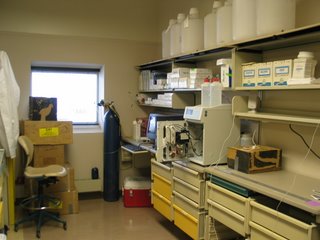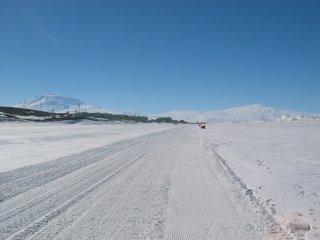Lake Hoare
 I spent last week at Lake Hoare. Lake Hoare camp is the main base of operation in the Taylor Valley and is the "home" of the McMurdo Dry Valleys LTER program. It has been many years since I was in the field in October and I have forgotten what it was like to be there so early in the summer. For one thing, the sun is not very high in the sky yet, so we spend most of the day in the shadow of the mountains. The lake ice is frozen solid. There are still snow patches on the ground. Here I am on Lake Hoare with the Canada Glacier in the background. It's not often that people can walk to work on a lake, but in Antarctica it is possible. This trip was a reconnaisance trip so that Kelly and I could start to look around at the ice to determine his sample locations. The lake ice becomes more treacherous later in the summer as it warms up and starts to melt. The part I am standing on might be melted later in the season, but for now it is somewhat like walking on a beautiful pale blue sidewalk. The ice at the center of the lake does not melt completely, but it will develope melt pools near the surface. The center ice is very rough and is about 4 meters thick. The lake itself is 30 meters deep at the deepest point.
I spent last week at Lake Hoare. Lake Hoare camp is the main base of operation in the Taylor Valley and is the "home" of the McMurdo Dry Valleys LTER program. It has been many years since I was in the field in October and I have forgotten what it was like to be there so early in the summer. For one thing, the sun is not very high in the sky yet, so we spend most of the day in the shadow of the mountains. The lake ice is frozen solid. There are still snow patches on the ground. Here I am on Lake Hoare with the Canada Glacier in the background. It's not often that people can walk to work on a lake, but in Antarctica it is possible. This trip was a reconnaisance trip so that Kelly and I could start to look around at the ice to determine his sample locations. The lake ice becomes more treacherous later in the summer as it warms up and starts to melt. The part I am standing on might be melted later in the season, but for now it is somewhat like walking on a beautiful pale blue sidewalk. The ice at the center of the lake does not melt completely, but it will develope melt pools near the surface. The center ice is very rough and is about 4 meters thick. The lake itself is 30 meters deep at the deepest point. 
Here is a picture of a Bell 212 helicopter. Helicopters the main means of transportation between McMurdo and the dry valleys. When we are in the field, the helicopters become our main physical connection to the outside world, transporting mail, supplies, food, and people. The helicopters also bring us back McMurdo when we are finished with our field work. It's hard not to love helicopters when you are in the dry valleys. The helicopter support is provided by PHI. Those pilots are so skilled at their jobs with many years of experience. The helicopters were transported back to the US this summer to undergo maintenance and they came back with shiny new red and blue paint colors.

Here is a picture of the camp at Lake Hoare showing the main building and the labs. Most of our power comes from solar power and there are three solar panels in front of the main hut. There are several other structures including a generator shed, a tool shed, an outhouse, two propane fueled "Rocket Toilets", and a Jamesway. We sleep in tents, but we have heat in the main building. The facilties are very comfortable, so we are not exactly roughing it. Although, sometimes we have to remind ourselves that we are working outside and sleeping in the cold so it is very important to eat enough and constantly monitor our physical condition. We do have warm shelters, but it's best to try to avoid getting too cold when we are outside. We use the main hut for cooking, working, and relaxing. We have a phone and internet access there. On our last night in Christchurch, we went out for Thai food and Kelly said "We won't be eating like this at Lake Hoare." I said, "Oh, yes we will." We have a wonderful camp manager at Lake Hoare who does not like to have her picture taken, but she makes sure we have delicious, interesting and nourishing meals every day.
 At this time of year we have direct sunlight from about 6AM to 2PM every day. The sun does not set at this time of year, but it is still low in the sky. It is hidden behing the mountains in the Asgard Range for most of the afternoon and evening. It feels like nap time. Then the sun pokes out from behind the mountains for another hour in the late evening. This picture was taken looking to the west from our camp. It is about 9PM. There is not much to say about this image except that the late evening is often the nicest time to be outside in the field.
At this time of year we have direct sunlight from about 6AM to 2PM every day. The sun does not set at this time of year, but it is still low in the sky. It is hidden behing the mountains in the Asgard Range for most of the afternoon and evening. It feels like nap time. Then the sun pokes out from behind the mountains for another hour in the late evening. This picture was taken looking to the west from our camp. It is about 9PM. There is not much to say about this image except that the late evening is often the nicest time to be outside in the field.






